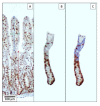Efficacy of Mycotoxin Detoxifiers on Health and Growth of Newly-Weaned Pigs under Chronic Dietary Challenge of Deoxynivalenol
- PMID: 32397551
- PMCID: PMC7290511
- DOI: 10.3390/toxins12050311
Efficacy of Mycotoxin Detoxifiers on Health and Growth of Newly-Weaned Pigs under Chronic Dietary Challenge of Deoxynivalenol
Abstract
The efficacy of yeast-based mycotoxin detoxifiers on health and growth performance of newly-weaned pigs (27-d-old) fed diets naturally contaminated with deoxynivalenol was investigated. Sixty pigs were individually assigned to five treatments for 34 d: NC (negative control, 1.2 mg/kg of deoxynivalenol); PC (positive control, 3.2 mg/kg of deoxynivalenol); CYC (PC + clay/yeast culture-based product, 0.2%); CYE (PC + clay/yeast cell wall/plant extracts/antioxidants-based product, 0.2%); and CYB (PC + clay/inactivated yeast/botanicals/antioxidants-based product, 0.2%). Blood and jejunal mucosa were sampled, and data were analyzed using Proc Mixed of SAS with pre-planned contrasts. Deoxynivalenol reduced the average daily gain (ADG) in phase 3. Pigs fed CYC had greater overall ADG, average daily feed intake during phase 3, and gain to feed ratio during phase 2 than PC. At d 14, deoxynivalenol reduced blood urea nitrogen/creatinine and tended to reduce blood urea nitrogen. Pigs fed CYB tended to have greater aspartate aminotransferase than PC. At d 34, pigs fed CYC and CYB tended to have lower serum creatine phosphokinase than PC. Pigs fed CYE had lower blood urea nitrogen/creatinine than PC. In jejunal mucosa, deoxynivalenol tended to increase malondialdehydes and decrease glutathione. Pigs fed CYE and CYB had lower malondialdehydes, pigs fed CYB had greater glutathione and tended to have lower immunoglobulin A than PC. Pigs fed CYC and CYE tended to have lower interleukin 8 than PC. In summary, deoxynivalenol challenge (1.2 vs. 3.2 mg/kg) mildly compromised growth performance and increased the oxidative stress of pigs. Mycotoxin detoxifiers could partially overcome deoxynivalenol toxicity enhancing liver health, whereas CYE and CYB reduced oxidative stress, and CYC and CYB reduced immune activation. In conclusion, yeast-based detoxifiers with functional components as clay/inactivated yeast/botanicals/antioxidants had increased detoxifying properties in newly-weaned pigs challenged with deoxynivalenol, potentially by enhancing adsorbability, immune function, gut health, and reducing oxidative stress.
Keywords: deoxynivalenol; health; yeast.
Conflict of interest statement
The authors declare no conflict of interest.
Figures




Similar articles
-
Investigation of the Efficacy of a Postbiotic Yeast Cell Wall-Based Blend on Newly-Weaned Pigs under a Dietary Challenge of Multiple Mycotoxins with Emphasis on Deoxynivalenol.Toxins (Basel). 2020 Aug 6;12(8):504. doi: 10.3390/toxins12080504. Toxins (Basel). 2020. PMID: 32781569 Free PMC article.
-
Investigation of the efficacy of mycotoxin-detoxifying additive on health and growth of newly-weaned pigs under deoxynivalenol challenges.Anim Biosci. 2021 Mar;34(3):405-416. doi: 10.5713/ajas.20.0567. Epub 2020 Oct 20. Anim Biosci. 2021. PMID: 33152208 Free PMC article.
-
Protective effect of two yeast based feed additives on pigs chronically exposed to deoxynivalenol and zearalenone.Toxins (Basel). 2014 Dec 12;6(12):3336-53. doi: 10.3390/toxins6123336. Toxins (Basel). 2014. PMID: 25533517 Free PMC article.
-
Mycotoxin Occurrence, Toxicity, and Detoxifying Agents in Pig Production with an Emphasis on Deoxynivalenol.Toxins (Basel). 2021 Feb 23;13(2):171. doi: 10.3390/toxins13020171. Toxins (Basel). 2021. PMID: 33672250 Free PMC article. Review.
-
Non-antibiotic feed additives in diets for pigs: A review.Anim Nutr. 2018 Jun;4(2):113-125. doi: 10.1016/j.aninu.2018.01.007. Epub 2018 Feb 8. Anim Nutr. 2018. PMID: 30140751 Free PMC article. Review.
Cited by
-
Protective effects of biological feed additives on gut microbiota and the health of pigs exposed to deoxynivalenol: a review.J Anim Sci Technol. 2022 Jul;64(4):640-653. doi: 10.5187/jast.2022.e40. Epub 2022 Jul 31. J Anim Sci Technol. 2022. PMID: 35969702 Free PMC article. Review.
-
Comparative efficacy of commercially available deoxynivalenol detoxifying feed additives on growth performance, total tract digestibility of components, and physiological responses in nursery pigs fed diets formulated with naturally contaminated corn.Transl Anim Sci. 2021 Mar 10;5(2):txab050. doi: 10.1093/tas/txab050. eCollection 2021 Apr. Transl Anim Sci. 2021. PMID: 34085027 Free PMC article.
-
Impacts of weaning weights and mycotoxin challenges on jejunal mucosa-associated microbiota, intestinal and systemic health, and growth performance of nursery pigs.J Anim Sci Biotechnol. 2022 Apr 13;13(1):43. doi: 10.1186/s40104-022-00691-6. J Anim Sci Biotechnol. 2022. PMID: 35413935 Free PMC article.
-
Protective effect of a new generation of activated and purified bentonite in combination with yeast and phytogenic substances on mycotoxin challenge in pigs.PLoS One. 2021 Oct 27;16(10):e0259132. doi: 10.1371/journal.pone.0259132. eCollection 2021. PLoS One. 2021. PMID: 34705867 Free PMC article.
-
Investigation of the Efficacy of a Postbiotic Yeast Cell Wall-Based Blend on Newly-Weaned Pigs under a Dietary Challenge of Multiple Mycotoxins with Emphasis on Deoxynivalenol.Toxins (Basel). 2020 Aug 6;12(8):504. doi: 10.3390/toxins12080504. Toxins (Basel). 2020. PMID: 32781569 Free PMC article.
References
-
- Abdallah M.F., Girgin G., Baydar T. Occurrence, prevention, and limitation of mycotoxins in feeds. Anim. Nutr. Feed Technol. 2015;15:471–490. doi: 10.5958/0974-181X.2015.00048.7. - DOI
-
- Curry S., Hendel E.G., Gott P., Murugesan G.R., Hofstetter-Schähs U. 170 Trends in mycotoxin contamination in the United States corn. J. Anim. Sci. 2019;97:93–94. doi: 10.1093/jas/skz122.169. - DOI
Publication types
MeSH terms
Substances
LinkOut - more resources
Full Text Sources
Medical

